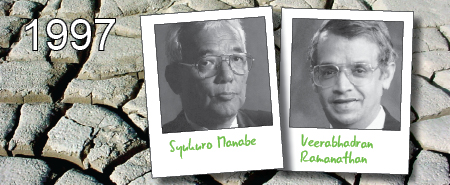V. Ramanathan is a bright star in climate research. His field of research especially regards the energy budget of the earth’s atmosphere system. He was among the first to point out the role of other gases in the atmosphere than CO2 for the climate, namely methane, nitrous oxide, CFC, and others.
Global Warming – Dimming the Sun
Personal web site:
http://www-ramanathan.ucsd.edu/
Biography:
http://www-ramanathan.ucsd.edu/PNAS_Bio.pdf
Nature Geoscience Paper, March 23, 2008
Ramanatans research show that Black Carbon Pollution Emerges as Major Player in Global Warming. Soot from biomass burning, diesel exhaust has 60 percent of the effect of carbon dioxide on warming but mitigation offers immediate benefits. Black Carbon Pollution is most often produced from biomass burning, cooking with solid fuels and diesel exhaust.
“Ramanathan says previous conservative estimates of black carbon’s warming effect overlooked key factors–most importantly, the interaction between black carbon and other particles in the atmosphere. “Black carbon doesn’t exist by itself,” says Ramanathan. “It’s always mixed with other aerosols,” such as sulfate particles, and other organic combustion byproducts. Many of those other aerosols reflect light, increasing the chances that it will be absorbed by nearby flecks of soot. Black carbon high in the atmosphere also absorbs light reflected by Earth’s surface and clouds. Because most climate models don’t adequately represent such effects, they often underestimate how much reflected light soot absorbs, Ramanathan says.” Scince Magazine
“Study Fingers Soot as a Major Player in Global Warming”
http://www.sciencemag.org/cgi/content/full/319/5871/1745
Brown clouds
Together with Dr. Paul Crutzen he discovered the widespread existence of atmospheric brown clouds covering much of the Indian Ocean region. They found that the vast majority of the aerosols were anthropogenic in origin, and that the surface cooling caused by the aerosols is more important than the atmospheric heating. These atmospheric brown clouds may have masked as much as 50% of the surface heating caused by the increase in CO2, and caused reduced precipitation during the Indian monsoon. (Wikipedia)
Now:
Today Veerabhadran Ramanathan tours the globe to conduct experiments and advise world leaders about climate change.
Project Surya
Ramanathan’s desire to go beyond publishing studies in journals and make a tangible difference has grown with time. Project Surya, which means Sun in Sanskrit, is a project that will promote the use of inexpensive solar cookers in rural India, and document the reductions in carbon dioxide and soot emissions. The idea is to give about 3,500 solar and other “clean energy” cooking devices to families in Mukteshwar, a rural area in the Himalayas, and study if the smokeless cookers effectively slash levels of atmospheric soot. http://www-ramanathan.ucsd.edu/ProjectSurya.html
CV
Professor at Scripps Institution of Oceanography, 1990-present;
director of the Center for Clouds, Chemistry and Climate at Scripps, 1991-present;
co-chief scientist for the Indian Ocean Experiment, 1996-2002;
professor at University of Chicago, 1986-1990
[E1]unclear


